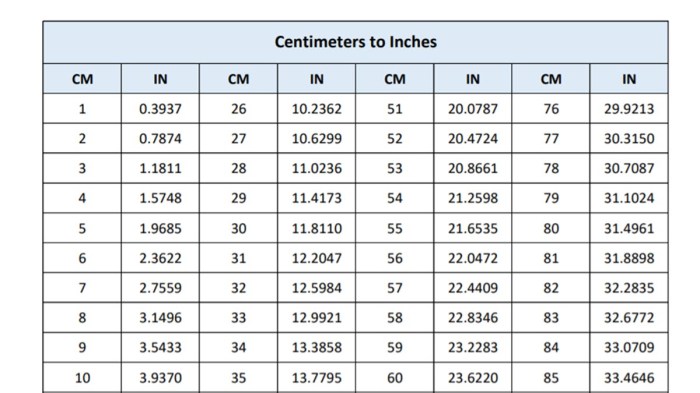Delving into the realm of inches to centimeters, we embark on a journey of understanding the intricacies of converting between imperial and metric units. From understanding the mathematical formula to exploring real-life applications, this guide unravels the complexities of inches to cm conversion, empowering you with the knowledge to navigate the world of measurements with precision.
Whether you’re a seasoned professional in carpentry or fashion, or simply curious about the relationship between these units, this comprehensive guide provides a wealth of information to cater to your needs.
Conversion Methods: Inches To Cm

Converting inches to centimeters is a fundamental task in many fields, such as engineering, construction, and science. To perform this conversion accurately, it’s essential to understand the mathematical formula and follow a step-by-step process.
The mathematical formula for converting inches to centimeters is:
centimeters = inches × 2.54
Where:
- centimeters is the equivalent measurement in centimeters
- inches is the given measurement in inches
- 2.54 is the conversion factor (1 inch = 2.54 centimeters)
Step-by-Step Guide
To convert inches to centimeters, follow these steps:
- Multiply the number of inches by 2.54.
- The result will be the equivalent measurement in centimeters.
Significance of the Conversion Factor
The conversion factor of 2.54 cm per inch is a crucial value that ensures accurate conversions. This factor represents the relationship between the imperial and metric systems of measurement. By using this conversion factor, we can convert inches to centimeters with precision.
Examples and Use Cases
Converting inches to centimeters is essential in various practical scenarios. The following table provides common measurements in inches and their corresponding values in centimeters:
| Inches | Centimeters |
|---|---|
| 1 inch | 2.54 cm |
| 2 inches | 5.08 cm |
| 3 inches | 7.62 cm |
| 4 inches | 10.16 cm |
| 5 inches | 12.7 cm |
Real-life examples of when inches-to-cm conversion is necessary include:
Carpentry
- Converting lumber measurements from inches to centimeters for precise cutting and assembly.
- Determining the appropriate drill bit size for screws and nails based on their diameter in centimeters.
Fashion, Inches to cm
- Converting garment measurements from inches to centimeters to ensure accurate sizing and fit.
- Determining the length of zippers, buttons, and other accessories in centimeters to match the garment’s measurements.
Conversion Accuracy
Accurate conversion is crucial for successful project outcomes. Incorrect conversions can lead to errors in measurements, cutting, and assembly, resulting in wasted materials and time.
Historical Perspective
The inch and centimeter (cm) are two units of length with distinct origins and histories.
The inch, derived from the Latin word “uncia,” meaning “twelfth,” was originally defined as one-twelfth of a Roman foot. This definition has persisted through the centuries, with the modern inch standardized to 2.54 centimeters.
To help you visualize the dimensions of a queen bed, it’s helpful to convert the measurements from inches to centimeters. For instance, a standard queen bed in the US measures 60 inches wide by 80 inches long, which translates to approximately 152.4 centimeters wide by 203.2 centimeters long.
This knowledge of inches to centimeters can be useful when shopping for bedding or comparing the dimensions of different queen bed models. Queen bed dimensions can vary slightly depending on the manufacturer, so it’s always a good idea to check the specific measurements before making a purchase.
Evolution of Conversion Methods
Historically, converting inches to centimeters and vice versa required manual calculations using conversion factors. In the 19th century, the metric system gained prominence, and conversion tables and slide rules became common tools for engineers and scientists.
Standardization
In 1875, the International Bureau of Weights and Measures (BIPM) was established to ensure the uniformity of measurement standards globally. BIPM defined the meter as the base unit of length, and the inch was subsequently defined as 2.54 centimeters, standardizing the conversion between the two units.
If you’re converting inches to cm for a DIY tissue box cover , accuracy is key. For instance, a 6-inch square cover would translate to approximately 15.24 cm. Remember, precise measurements ensure a snug fit for your tissue box.
International Standards

The establishment of a standardized system of measurement has played a pivotal role in facilitating global communication and collaboration in scientific, engineering, and commercial fields. The International System of Units (SI), developed and maintained by the International Bureau of Weights and Measures (BIPM), serves as the foundation for a coherent and universally accepted set of units.
Within the SI system, the centimeter (cm) has been designated as the standard unit of length. This designation ensures consistency and accuracy in measurements and calculations across different countries and disciplines.
Adoption of the Metric System
The adoption of the metric system, based on the SI units, has gained widespread acceptance globally. Many countries have implemented the metric system as their official system of measurement, including most European nations, as well as countries in Asia, Africa, and South America.
The metric system offers several advantages, including its decimal-based structure, which simplifies conversions between different units. Additionally, the use of prefixes (such as kilo-, centi-, and milli-) allows for convenient expression of values over a wide range of magnitudes.
Challenges and Benefits of Standardized Conversion
While the adoption of standardized conversion systems, such as the metric system, brings numerous benefits, it also presents certain challenges.
- Resistance to Change:Transitioning to a new measurement system can be met with resistance from individuals and organizations accustomed to traditional units.
- Cost of Implementation:Implementing a new measurement system can involve significant costs, particularly for industries that rely heavily on specialized equipment calibrated to specific units.
- Educational Challenges:Educating the public and professionals about the new system and its applications can be a time-consuming and resource-intensive process.
Despite these challenges, the benefits of standardized conversion systems far outweigh the drawbacks. The use of a common set of units promotes accuracy, facilitates international collaboration, and enhances the efficiency of scientific and industrial processes.
When it comes to measuring furniture, it’s helpful to know that 1 inch is equivalent to 2.54 centimeters. This conversion comes in handy when you’re browsing online for a new king bed frame . With its ample sleeping space, a king bed frame is a great choice for couples or anyone who enjoys stretching out.
And with so many different styles and designs to choose from, you’re sure to find the perfect bed frame to complement your bedroom décor. So, whether you’re measuring for a new bed frame or simply curious about the conversion, remember that 1 inch is equal to 2.54 centimeters.
Tools and Resources
In the digital age, a plethora of online tools and resources are readily available to facilitate inches-to-cm conversions with ease and precision.
These tools employ sophisticated algorithms and databases to ensure accurate and reliable conversions, catering to a wide range of user needs.
Online Conversion Tools
- Google Search:Simply type “inches to cm” in the search bar, and Google will instantly provide the conversion result.
- Online Conversion Websites:Dedicated websites like ConvertWorld and Unit Converters offer comprehensive conversion calculators for various units, including inches and centimeters.
- Smartphone Apps:Mobile applications such as Unit Converter and Converter Plus provide convenient conversion tools on the go.
Tips for Choosing the Right Tool
Selecting the most appropriate conversion tool depends on the specific requirements of the user.
- Accuracy:For critical applications, choose tools with high accuracy ratings.
- Ease of Use:Opt for tools with intuitive interfaces and user-friendly designs.
- Additional Features:Consider tools that offer additional features such as unit history, custom conversions, or multiple unit support.
Wrap-Up

As we conclude our exploration of inches to cm conversion, it’s evident that understanding the nuances of measurement systems is crucial for accuracy and precision in various fields. Embracing the International System of Units (SI) and utilizing reliable conversion tools empower us to seamlessly navigate the global language of measurements.
Whether you’re working on a construction project or simply converting measurements for personal use, this guide serves as a valuable resource, ensuring that your conversions are accurate and reliable.
Question Bank
What is the mathematical formula for converting inches to cm?
To convert inches to cm, multiply the inch value by 2.54 cm/inch.
How do I convert 5 inches to cm?
5 inches = 5 x 2.54 cm = 12.7 cm
Why is the conversion factor 2.54 cm/inch?
The conversion factor is 2.54 cm/inch because 1 inch is defined as 2.54 centimeters.
What are some real-life examples of when inches-to-cm conversion is necessary?
Inches-to-cm conversion is necessary in various fields, such as carpentry (converting measurements for building plans), fashion (converting garment sizes), and engineering (converting measurements for technical drawings).




Leave a Comment